Current Developments in Accounting Thought: A Comprehensive Analysis
VerifiedAdded on 2022/10/10
|15
|3602
|173
Report
AI Summary
This report delves into current developments in accounting, examining the evolution of conceptual frameworks and their advantages in guiding accounting and financial reporting. It discusses the legitimacy of standard-setters amidst potential government intervention, highlighting the role of lobbying and the importance of professional standards. The report also explores the relevance of historical cost versus fair value to financial statement users, analyzing the merits of each approach and their impact on the reliability and relevance of financial information. Furthermore, the report investigates the enduring acceptability of historical cost accounting, contrasting it with alternative methods proposed by various authors, and providing insights into the strengths and weaknesses of each approach. The analysis emphasizes the importance of understanding these developments for informed decision-making in financial reporting.
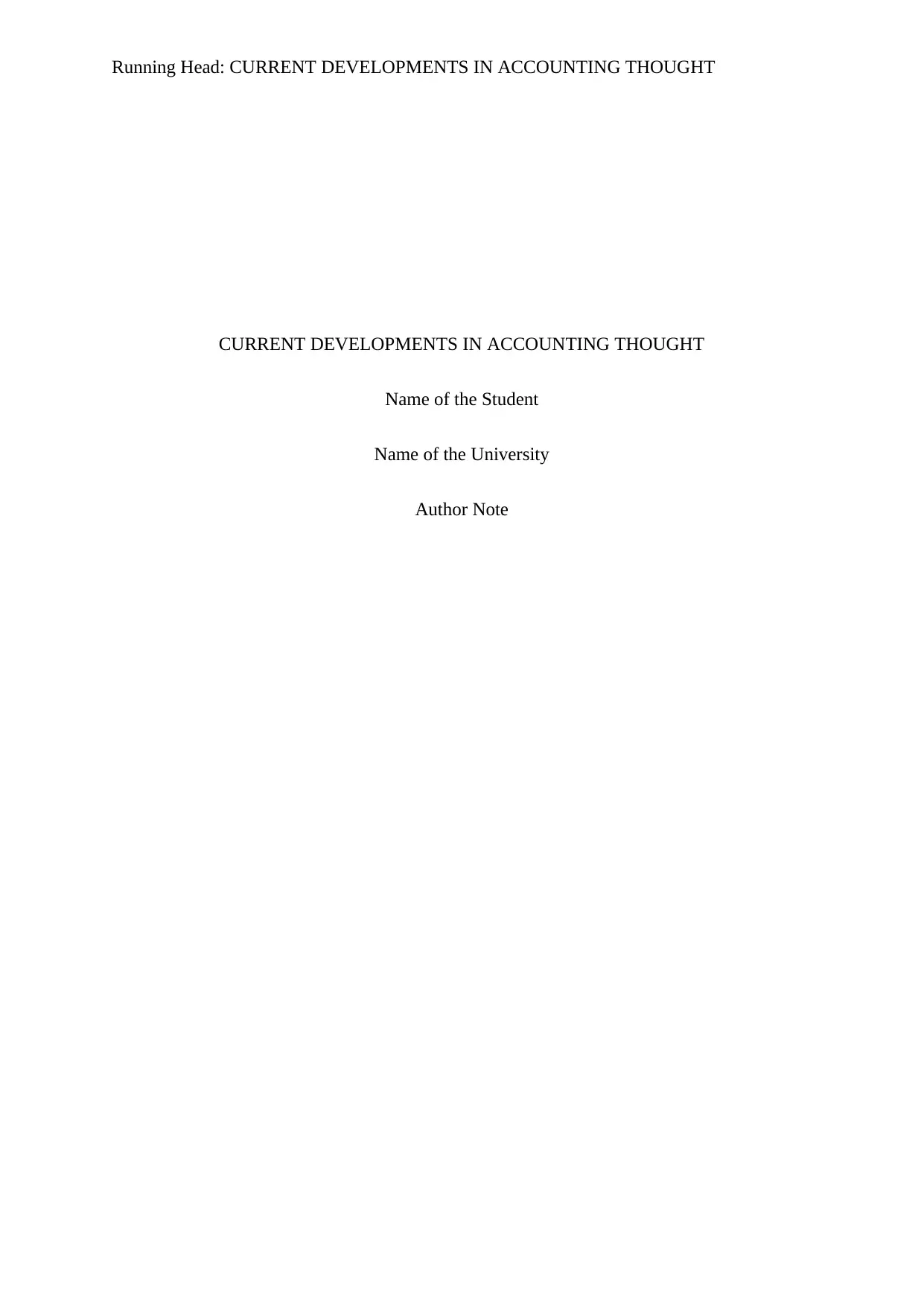
Running Head: CURRENT DEVELOPMENTS IN ACCOUNTING THOUGHT
CURRENT DEVELOPMENTS IN ACCOUNTING THOUGHT
Name of the Student
Name of the University
Author Note
CURRENT DEVELOPMENTS IN ACCOUNTING THOUGHT
Name of the Student
Name of the University
Author Note
Paraphrase This Document
Need a fresh take? Get an instant paraphrase of this document with our AI Paraphraser
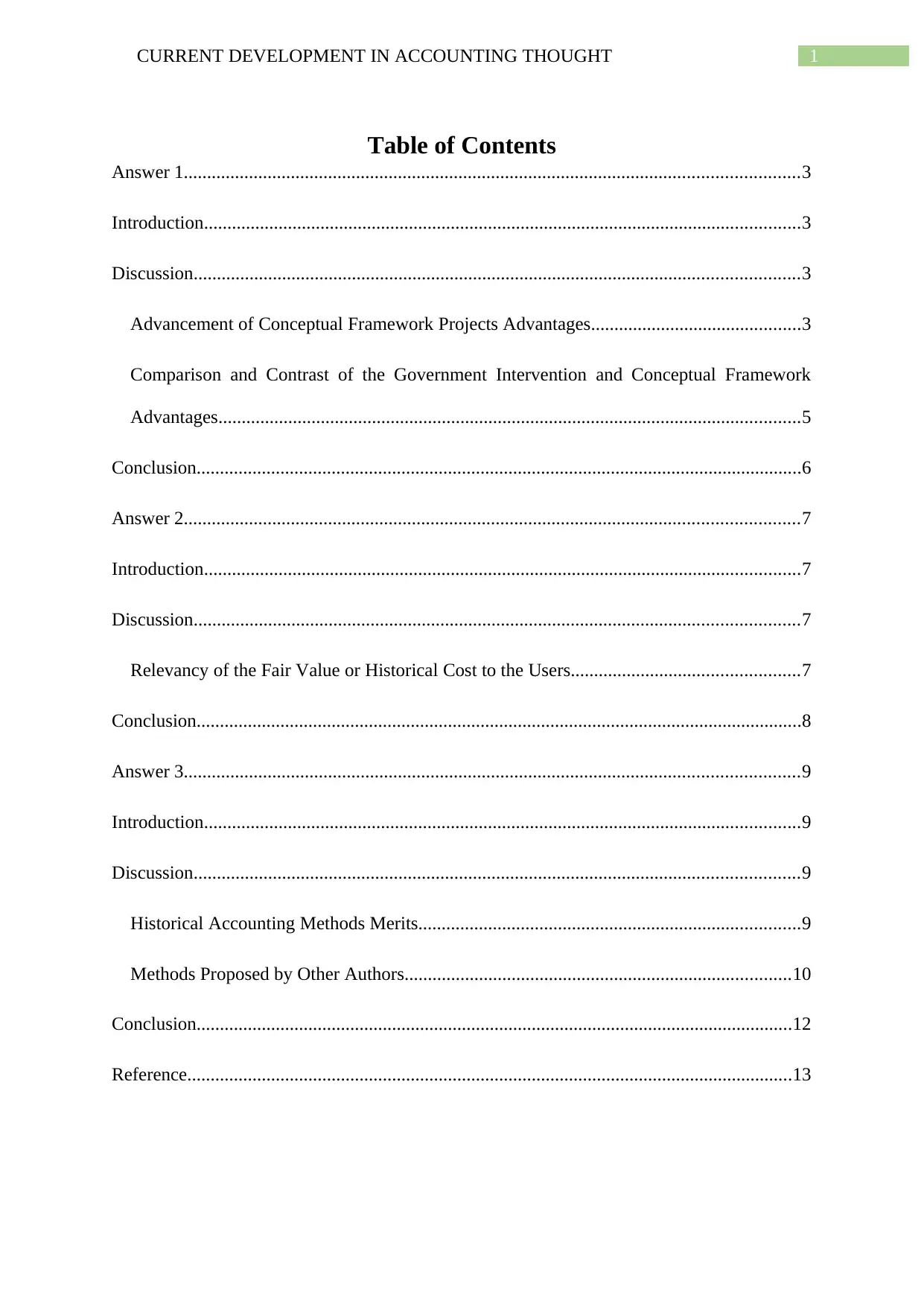
1CURRENT DEVELOPMENT IN ACCOUNTING THOUGHT
Table of Contents
Answer 1....................................................................................................................................3
Introduction................................................................................................................................3
Discussion..................................................................................................................................3
Advancement of Conceptual Framework Projects Advantages.............................................3
Comparison and Contrast of the Government Intervention and Conceptual Framework
Advantages.............................................................................................................................5
Conclusion..................................................................................................................................6
Answer 2....................................................................................................................................7
Introduction................................................................................................................................7
Discussion..................................................................................................................................7
Relevancy of the Fair Value or Historical Cost to the Users.................................................7
Conclusion..................................................................................................................................8
Answer 3....................................................................................................................................9
Introduction................................................................................................................................9
Discussion..................................................................................................................................9
Historical Accounting Methods Merits..................................................................................9
Methods Proposed by Other Authors...................................................................................10
Conclusion................................................................................................................................12
Reference..................................................................................................................................13
Table of Contents
Answer 1....................................................................................................................................3
Introduction................................................................................................................................3
Discussion..................................................................................................................................3
Advancement of Conceptual Framework Projects Advantages.............................................3
Comparison and Contrast of the Government Intervention and Conceptual Framework
Advantages.............................................................................................................................5
Conclusion..................................................................................................................................6
Answer 2....................................................................................................................................7
Introduction................................................................................................................................7
Discussion..................................................................................................................................7
Relevancy of the Fair Value or Historical Cost to the Users.................................................7
Conclusion..................................................................................................................................8
Answer 3....................................................................................................................................9
Introduction................................................................................................................................9
Discussion..................................................................................................................................9
Historical Accounting Methods Merits..................................................................................9
Methods Proposed by Other Authors...................................................................................10
Conclusion................................................................................................................................12
Reference..................................................................................................................................13
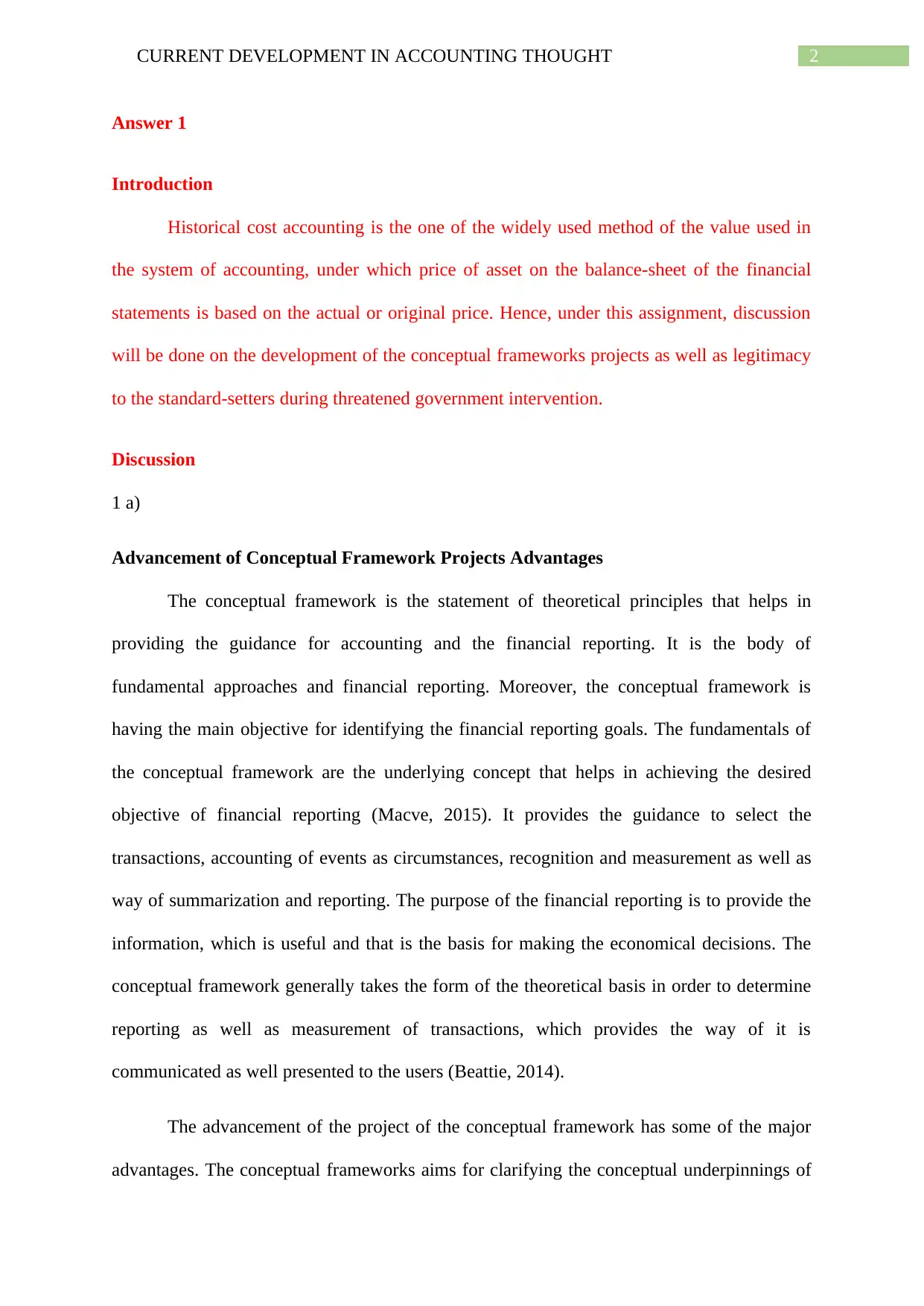
2CURRENT DEVELOPMENT IN ACCOUNTING THOUGHT
Answer 1
Introduction
Historical cost accounting is the one of the widely used method of the value used in
the system of accounting, under which price of asset on the balance-sheet of the financial
statements is based on the actual or original price. Hence, under this assignment, discussion
will be done on the development of the conceptual frameworks projects as well as legitimacy
to the standard-setters during threatened government intervention.
Discussion
1 a)
Advancement of Conceptual Framework Projects Advantages
The conceptual framework is the statement of theoretical principles that helps in
providing the guidance for accounting and the financial reporting. It is the body of
fundamental approaches and financial reporting. Moreover, the conceptual framework is
having the main objective for identifying the financial reporting goals. The fundamentals of
the conceptual framework are the underlying concept that helps in achieving the desired
objective of financial reporting (Macve, 2015). It provides the guidance to select the
transactions, accounting of events as circumstances, recognition and measurement as well as
way of summarization and reporting. The purpose of the financial reporting is to provide the
information, which is useful and that is the basis for making the economical decisions. The
conceptual framework generally takes the form of the theoretical basis in order to determine
reporting as well as measurement of transactions, which provides the way of it is
communicated as well presented to the users (Beattie, 2014).
The advancement of the project of the conceptual framework has some of the major
advantages. The conceptual frameworks aims for clarifying the conceptual underpinnings of
Answer 1
Introduction
Historical cost accounting is the one of the widely used method of the value used in
the system of accounting, under which price of asset on the balance-sheet of the financial
statements is based on the actual or original price. Hence, under this assignment, discussion
will be done on the development of the conceptual frameworks projects as well as legitimacy
to the standard-setters during threatened government intervention.
Discussion
1 a)
Advancement of Conceptual Framework Projects Advantages
The conceptual framework is the statement of theoretical principles that helps in
providing the guidance for accounting and the financial reporting. It is the body of
fundamental approaches and financial reporting. Moreover, the conceptual framework is
having the main objective for identifying the financial reporting goals. The fundamentals of
the conceptual framework are the underlying concept that helps in achieving the desired
objective of financial reporting (Macve, 2015). It provides the guidance to select the
transactions, accounting of events as circumstances, recognition and measurement as well as
way of summarization and reporting. The purpose of the financial reporting is to provide the
information, which is useful and that is the basis for making the economical decisions. The
conceptual framework generally takes the form of the theoretical basis in order to determine
reporting as well as measurement of transactions, which provides the way of it is
communicated as well presented to the users (Beattie, 2014).
The advancement of the project of the conceptual framework has some of the major
advantages. The conceptual frameworks aims for clarifying the conceptual underpinnings of
⊘ This is a preview!⊘
Do you want full access?
Subscribe today to unlock all pages.

Trusted by 1+ million students worldwide
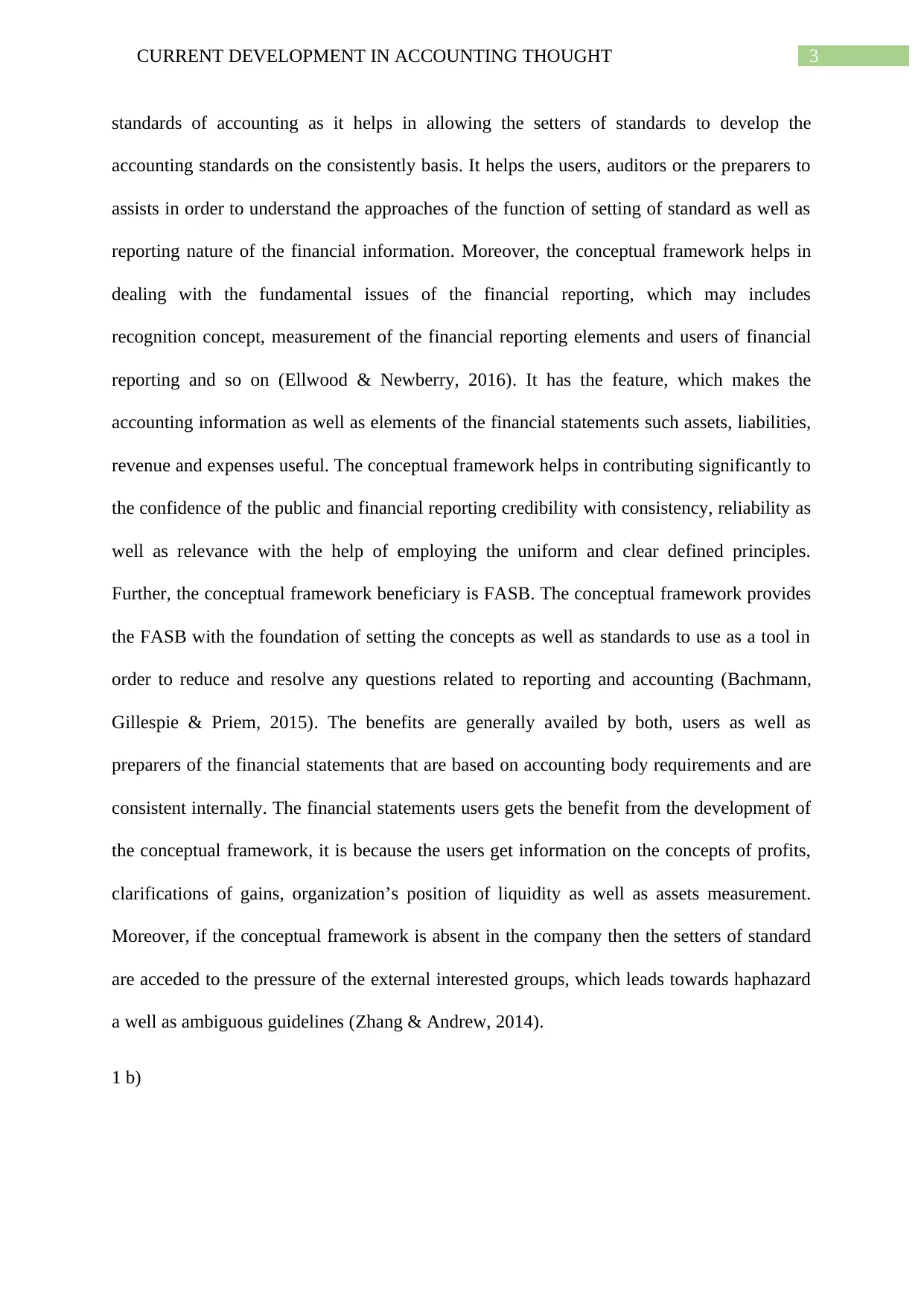
3CURRENT DEVELOPMENT IN ACCOUNTING THOUGHT
standards of accounting as it helps in allowing the setters of standards to develop the
accounting standards on the consistently basis. It helps the users, auditors or the preparers to
assists in order to understand the approaches of the function of setting of standard as well as
reporting nature of the financial information. Moreover, the conceptual framework helps in
dealing with the fundamental issues of the financial reporting, which may includes
recognition concept, measurement of the financial reporting elements and users of financial
reporting and so on (Ellwood & Newberry, 2016). It has the feature, which makes the
accounting information as well as elements of the financial statements such assets, liabilities,
revenue and expenses useful. The conceptual framework helps in contributing significantly to
the confidence of the public and financial reporting credibility with consistency, reliability as
well as relevance with the help of employing the uniform and clear defined principles.
Further, the conceptual framework beneficiary is FASB. The conceptual framework provides
the FASB with the foundation of setting the concepts as well as standards to use as a tool in
order to reduce and resolve any questions related to reporting and accounting (Bachmann,
Gillespie & Priem, 2015). The benefits are generally availed by both, users as well as
preparers of the financial statements that are based on accounting body requirements and are
consistent internally. The financial statements users gets the benefit from the development of
the conceptual framework, it is because the users get information on the concepts of profits,
clarifications of gains, organization’s position of liquidity as well as assets measurement.
Moreover, if the conceptual framework is absent in the company then the setters of standard
are acceded to the pressure of the external interested groups, which leads towards haphazard
a well as ambiguous guidelines (Zhang & Andrew, 2014).
1 b)
standards of accounting as it helps in allowing the setters of standards to develop the
accounting standards on the consistently basis. It helps the users, auditors or the preparers to
assists in order to understand the approaches of the function of setting of standard as well as
reporting nature of the financial information. Moreover, the conceptual framework helps in
dealing with the fundamental issues of the financial reporting, which may includes
recognition concept, measurement of the financial reporting elements and users of financial
reporting and so on (Ellwood & Newberry, 2016). It has the feature, which makes the
accounting information as well as elements of the financial statements such assets, liabilities,
revenue and expenses useful. The conceptual framework helps in contributing significantly to
the confidence of the public and financial reporting credibility with consistency, reliability as
well as relevance with the help of employing the uniform and clear defined principles.
Further, the conceptual framework beneficiary is FASB. The conceptual framework provides
the FASB with the foundation of setting the concepts as well as standards to use as a tool in
order to reduce and resolve any questions related to reporting and accounting (Bachmann,
Gillespie & Priem, 2015). The benefits are generally availed by both, users as well as
preparers of the financial statements that are based on accounting body requirements and are
consistent internally. The financial statements users gets the benefit from the development of
the conceptual framework, it is because the users get information on the concepts of profits,
clarifications of gains, organization’s position of liquidity as well as assets measurement.
Moreover, if the conceptual framework is absent in the company then the setters of standard
are acceded to the pressure of the external interested groups, which leads towards haphazard
a well as ambiguous guidelines (Zhang & Andrew, 2014).
1 b)
Paraphrase This Document
Need a fresh take? Get an instant paraphrase of this document with our AI Paraphraser
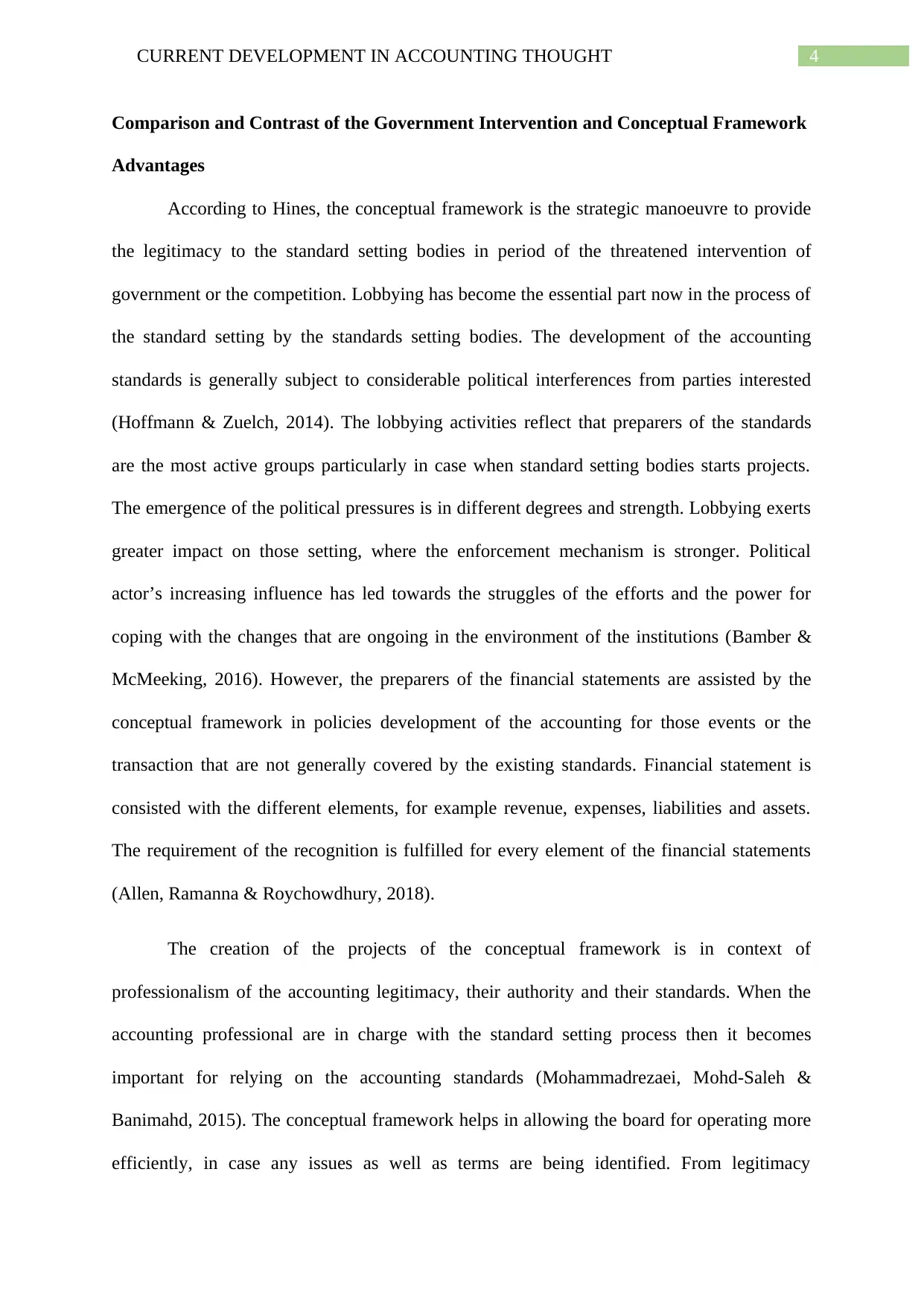
4CURRENT DEVELOPMENT IN ACCOUNTING THOUGHT
Comparison and Contrast of the Government Intervention and Conceptual Framework
Advantages
According to Hines, the conceptual framework is the strategic manoeuvre to provide
the legitimacy to the standard setting bodies in period of the threatened intervention of
government or the competition. Lobbying has become the essential part now in the process of
the standard setting by the standards setting bodies. The development of the accounting
standards is generally subject to considerable political interferences from parties interested
(Hoffmann & Zuelch, 2014). The lobbying activities reflect that preparers of the standards
are the most active groups particularly in case when standard setting bodies starts projects.
The emergence of the political pressures is in different degrees and strength. Lobbying exerts
greater impact on those setting, where the enforcement mechanism is stronger. Political
actor’s increasing influence has led towards the struggles of the efforts and the power for
coping with the changes that are ongoing in the environment of the institutions (Bamber &
McMeeking, 2016). However, the preparers of the financial statements are assisted by the
conceptual framework in policies development of the accounting for those events or the
transaction that are not generally covered by the existing standards. Financial statement is
consisted with the different elements, for example revenue, expenses, liabilities and assets.
The requirement of the recognition is fulfilled for every element of the financial statements
(Allen, Ramanna & Roychowdhury, 2018).
The creation of the projects of the conceptual framework is in context of
professionalism of the accounting legitimacy, their authority and their standards. When the
accounting professional are in charge with the standard setting process then it becomes
important for relying on the accounting standards (Mohammadrezaei, Mohd-Saleh &
Banimahd, 2015). The conceptual framework helps in allowing the board for operating more
efficiently, in case any issues as well as terms are being identified. From legitimacy
Comparison and Contrast of the Government Intervention and Conceptual Framework
Advantages
According to Hines, the conceptual framework is the strategic manoeuvre to provide
the legitimacy to the standard setting bodies in period of the threatened intervention of
government or the competition. Lobbying has become the essential part now in the process of
the standard setting by the standards setting bodies. The development of the accounting
standards is generally subject to considerable political interferences from parties interested
(Hoffmann & Zuelch, 2014). The lobbying activities reflect that preparers of the standards
are the most active groups particularly in case when standard setting bodies starts projects.
The emergence of the political pressures is in different degrees and strength. Lobbying exerts
greater impact on those setting, where the enforcement mechanism is stronger. Political
actor’s increasing influence has led towards the struggles of the efforts and the power for
coping with the changes that are ongoing in the environment of the institutions (Bamber &
McMeeking, 2016). However, the preparers of the financial statements are assisted by the
conceptual framework in policies development of the accounting for those events or the
transaction that are not generally covered by the existing standards. Financial statement is
consisted with the different elements, for example revenue, expenses, liabilities and assets.
The requirement of the recognition is fulfilled for every element of the financial statements
(Allen, Ramanna & Roychowdhury, 2018).
The creation of the projects of the conceptual framework is in context of
professionalism of the accounting legitimacy, their authority and their standards. When the
accounting professional are in charge with the standard setting process then it becomes
important for relying on the accounting standards (Mohammadrezaei, Mohd-Saleh &
Banimahd, 2015). The conceptual framework helps in allowing the board for operating more
efficiently, in case any issues as well as terms are being identified. From legitimacy
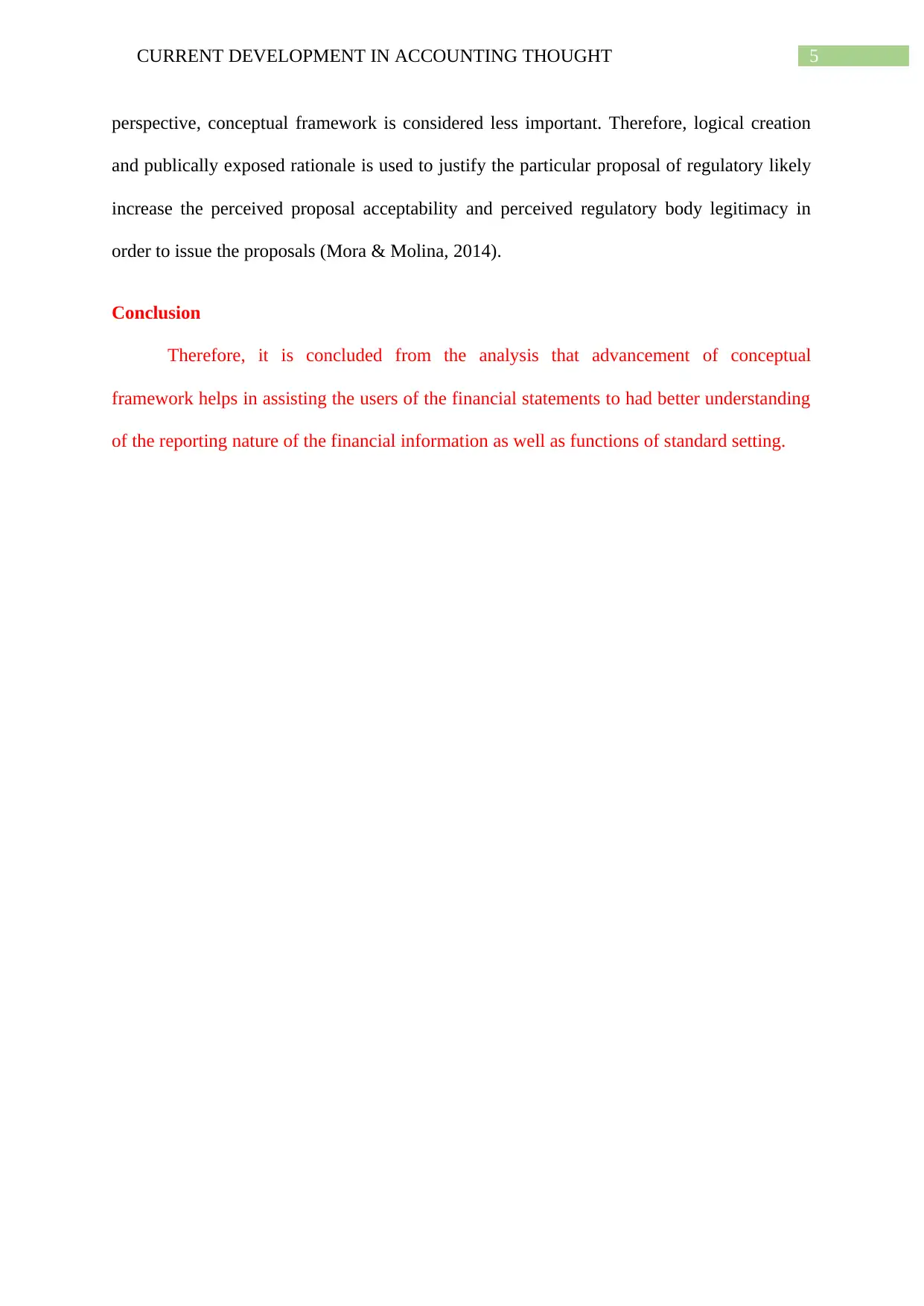
5CURRENT DEVELOPMENT IN ACCOUNTING THOUGHT
perspective, conceptual framework is considered less important. Therefore, logical creation
and publically exposed rationale is used to justify the particular proposal of regulatory likely
increase the perceived proposal acceptability and perceived regulatory body legitimacy in
order to issue the proposals (Mora & Molina, 2014).
Conclusion
Therefore, it is concluded from the analysis that advancement of conceptual
framework helps in assisting the users of the financial statements to had better understanding
of the reporting nature of the financial information as well as functions of standard setting.
perspective, conceptual framework is considered less important. Therefore, logical creation
and publically exposed rationale is used to justify the particular proposal of regulatory likely
increase the perceived proposal acceptability and perceived regulatory body legitimacy in
order to issue the proposals (Mora & Molina, 2014).
Conclusion
Therefore, it is concluded from the analysis that advancement of conceptual
framework helps in assisting the users of the financial statements to had better understanding
of the reporting nature of the financial information as well as functions of standard setting.
⊘ This is a preview!⊘
Do you want full access?
Subscribe today to unlock all pages.

Trusted by 1+ million students worldwide
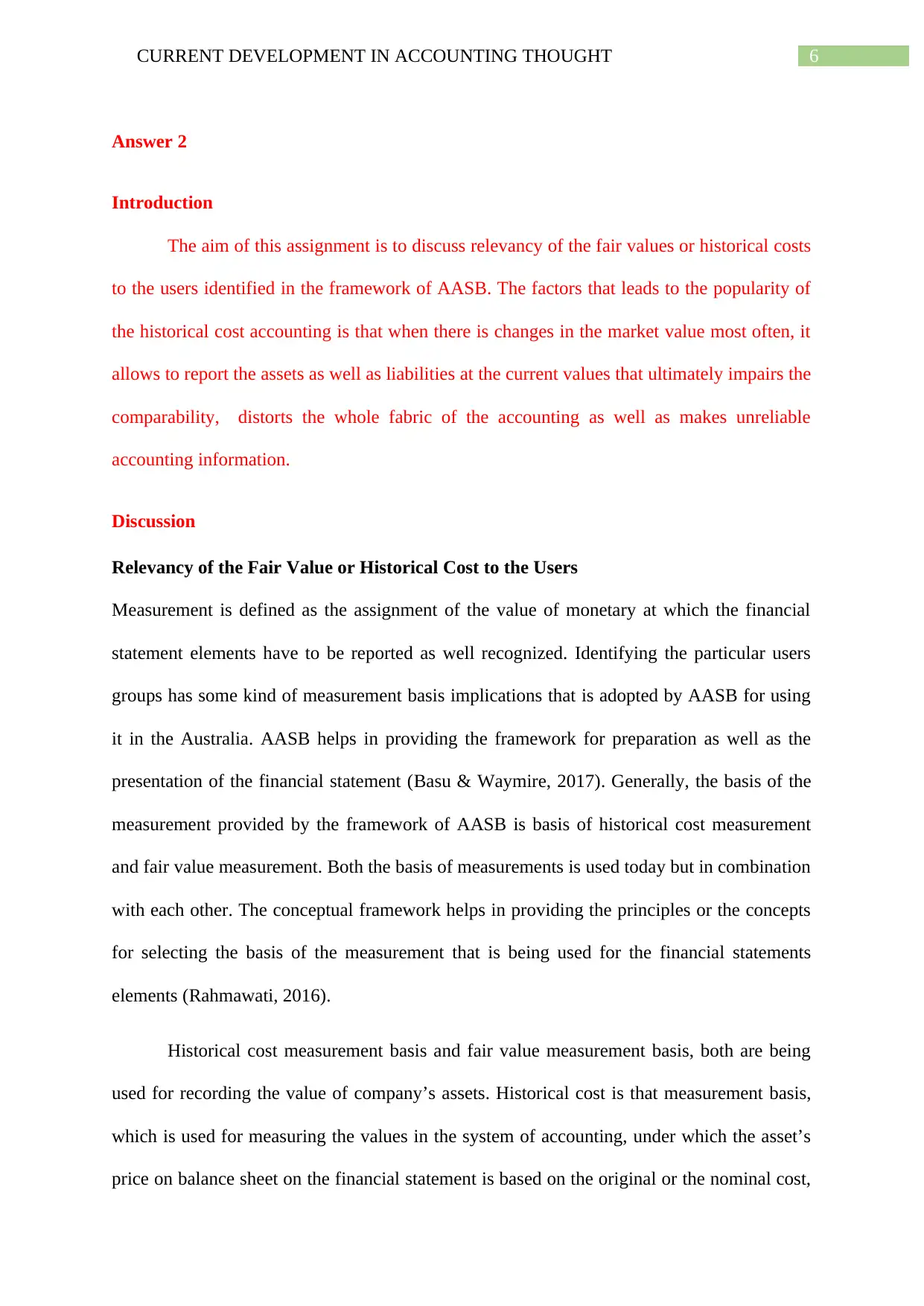
6CURRENT DEVELOPMENT IN ACCOUNTING THOUGHT
Answer 2
Introduction
The aim of this assignment is to discuss relevancy of the fair values or historical costs
to the users identified in the framework of AASB. The factors that leads to the popularity of
the historical cost accounting is that when there is changes in the market value most often, it
allows to report the assets as well as liabilities at the current values that ultimately impairs the
comparability, distorts the whole fabric of the accounting as well as makes unreliable
accounting information.
Discussion
Relevancy of the Fair Value or Historical Cost to the Users
Measurement is defined as the assignment of the value of monetary at which the financial
statement elements have to be reported as well recognized. Identifying the particular users
groups has some kind of measurement basis implications that is adopted by AASB for using
it in the Australia. AASB helps in providing the framework for preparation as well as the
presentation of the financial statement (Basu & Waymire, 2017). Generally, the basis of the
measurement provided by the framework of AASB is basis of historical cost measurement
and fair value measurement. Both the basis of measurements is used today but in combination
with each other. The conceptual framework helps in providing the principles or the concepts
for selecting the basis of the measurement that is being used for the financial statements
elements (Rahmawati, 2016).
Historical cost measurement basis and fair value measurement basis, both are being
used for recording the value of company’s assets. Historical cost is that measurement basis,
which is used for measuring the values in the system of accounting, under which the asset’s
price on balance sheet on the financial statement is based on the original or the nominal cost,
Answer 2
Introduction
The aim of this assignment is to discuss relevancy of the fair values or historical costs
to the users identified in the framework of AASB. The factors that leads to the popularity of
the historical cost accounting is that when there is changes in the market value most often, it
allows to report the assets as well as liabilities at the current values that ultimately impairs the
comparability, distorts the whole fabric of the accounting as well as makes unreliable
accounting information.
Discussion
Relevancy of the Fair Value or Historical Cost to the Users
Measurement is defined as the assignment of the value of monetary at which the financial
statement elements have to be reported as well recognized. Identifying the particular users
groups has some kind of measurement basis implications that is adopted by AASB for using
it in the Australia. AASB helps in providing the framework for preparation as well as the
presentation of the financial statement (Basu & Waymire, 2017). Generally, the basis of the
measurement provided by the framework of AASB is basis of historical cost measurement
and fair value measurement. Both the basis of measurements is used today but in combination
with each other. The conceptual framework helps in providing the principles or the concepts
for selecting the basis of the measurement that is being used for the financial statements
elements (Rahmawati, 2016).
Historical cost measurement basis and fair value measurement basis, both are being
used for recording the value of company’s assets. Historical cost is that measurement basis,
which is used for measuring the values in the system of accounting, under which the asset’s
price on balance sheet on the financial statement is based on the original or the nominal cost,
Paraphrase This Document
Need a fresh take? Get an instant paraphrase of this document with our AI Paraphraser
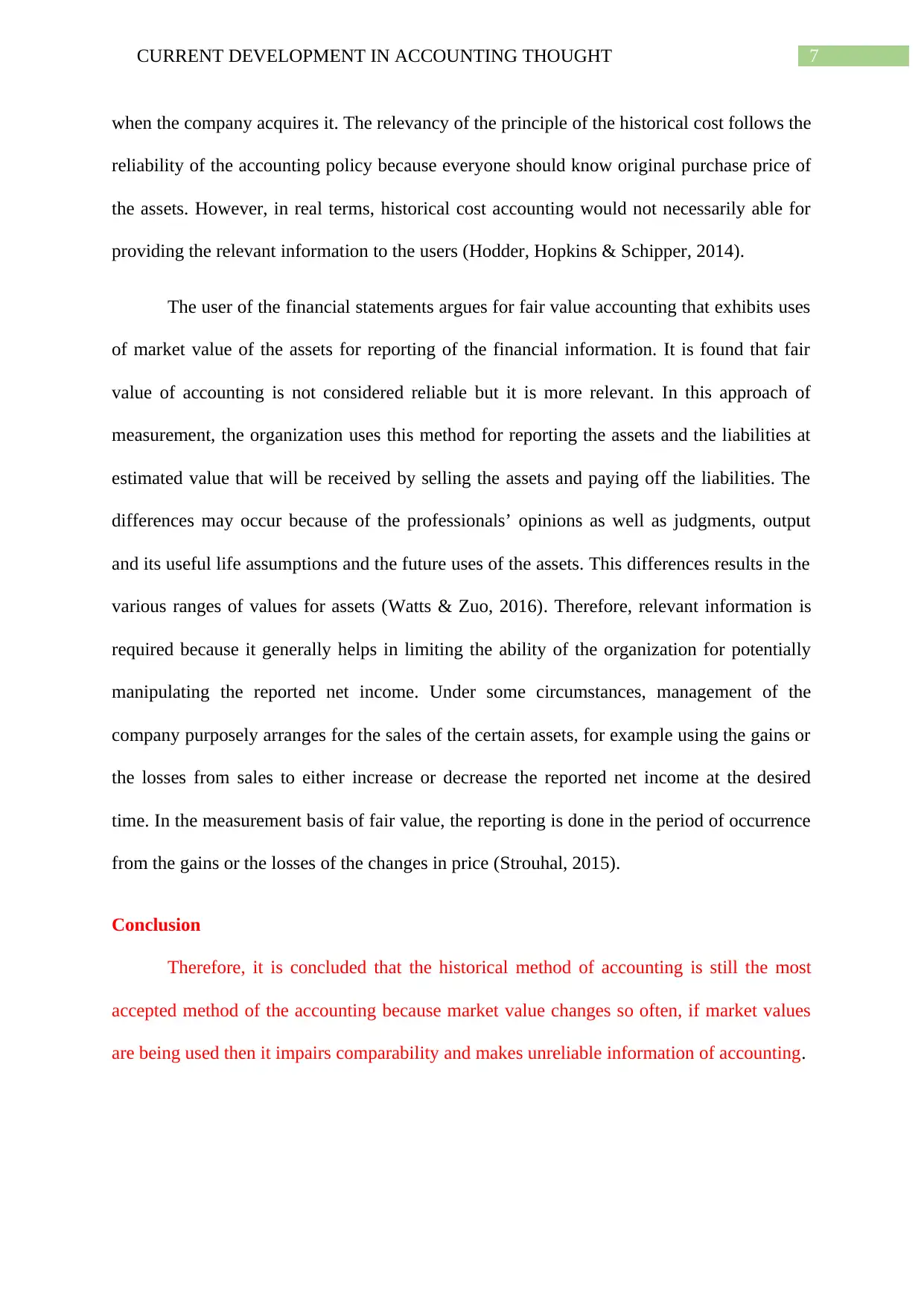
7CURRENT DEVELOPMENT IN ACCOUNTING THOUGHT
when the company acquires it. The relevancy of the principle of the historical cost follows the
reliability of the accounting policy because everyone should know original purchase price of
the assets. However, in real terms, historical cost accounting would not necessarily able for
providing the relevant information to the users (Hodder, Hopkins & Schipper, 2014).
The user of the financial statements argues for fair value accounting that exhibits uses
of market value of the assets for reporting of the financial information. It is found that fair
value of accounting is not considered reliable but it is more relevant. In this approach of
measurement, the organization uses this method for reporting the assets and the liabilities at
estimated value that will be received by selling the assets and paying off the liabilities. The
differences may occur because of the professionals’ opinions as well as judgments, output
and its useful life assumptions and the future uses of the assets. This differences results in the
various ranges of values for assets (Watts & Zuo, 2016). Therefore, relevant information is
required because it generally helps in limiting the ability of the organization for potentially
manipulating the reported net income. Under some circumstances, management of the
company purposely arranges for the sales of the certain assets, for example using the gains or
the losses from sales to either increase or decrease the reported net income at the desired
time. In the measurement basis of fair value, the reporting is done in the period of occurrence
from the gains or the losses of the changes in price (Strouhal, 2015).
Conclusion
Therefore, it is concluded that the historical method of accounting is still the most
accepted method of the accounting because market value changes so often, if market values
are being used then it impairs comparability and makes unreliable information of accounting.
when the company acquires it. The relevancy of the principle of the historical cost follows the
reliability of the accounting policy because everyone should know original purchase price of
the assets. However, in real terms, historical cost accounting would not necessarily able for
providing the relevant information to the users (Hodder, Hopkins & Schipper, 2014).
The user of the financial statements argues for fair value accounting that exhibits uses
of market value of the assets for reporting of the financial information. It is found that fair
value of accounting is not considered reliable but it is more relevant. In this approach of
measurement, the organization uses this method for reporting the assets and the liabilities at
estimated value that will be received by selling the assets and paying off the liabilities. The
differences may occur because of the professionals’ opinions as well as judgments, output
and its useful life assumptions and the future uses of the assets. This differences results in the
various ranges of values for assets (Watts & Zuo, 2016). Therefore, relevant information is
required because it generally helps in limiting the ability of the organization for potentially
manipulating the reported net income. Under some circumstances, management of the
company purposely arranges for the sales of the certain assets, for example using the gains or
the losses from sales to either increase or decrease the reported net income at the desired
time. In the measurement basis of fair value, the reporting is done in the period of occurrence
from the gains or the losses of the changes in price (Strouhal, 2015).
Conclusion
Therefore, it is concluded that the historical method of accounting is still the most
accepted method of the accounting because market value changes so often, if market values
are being used then it impairs comparability and makes unreliable information of accounting.
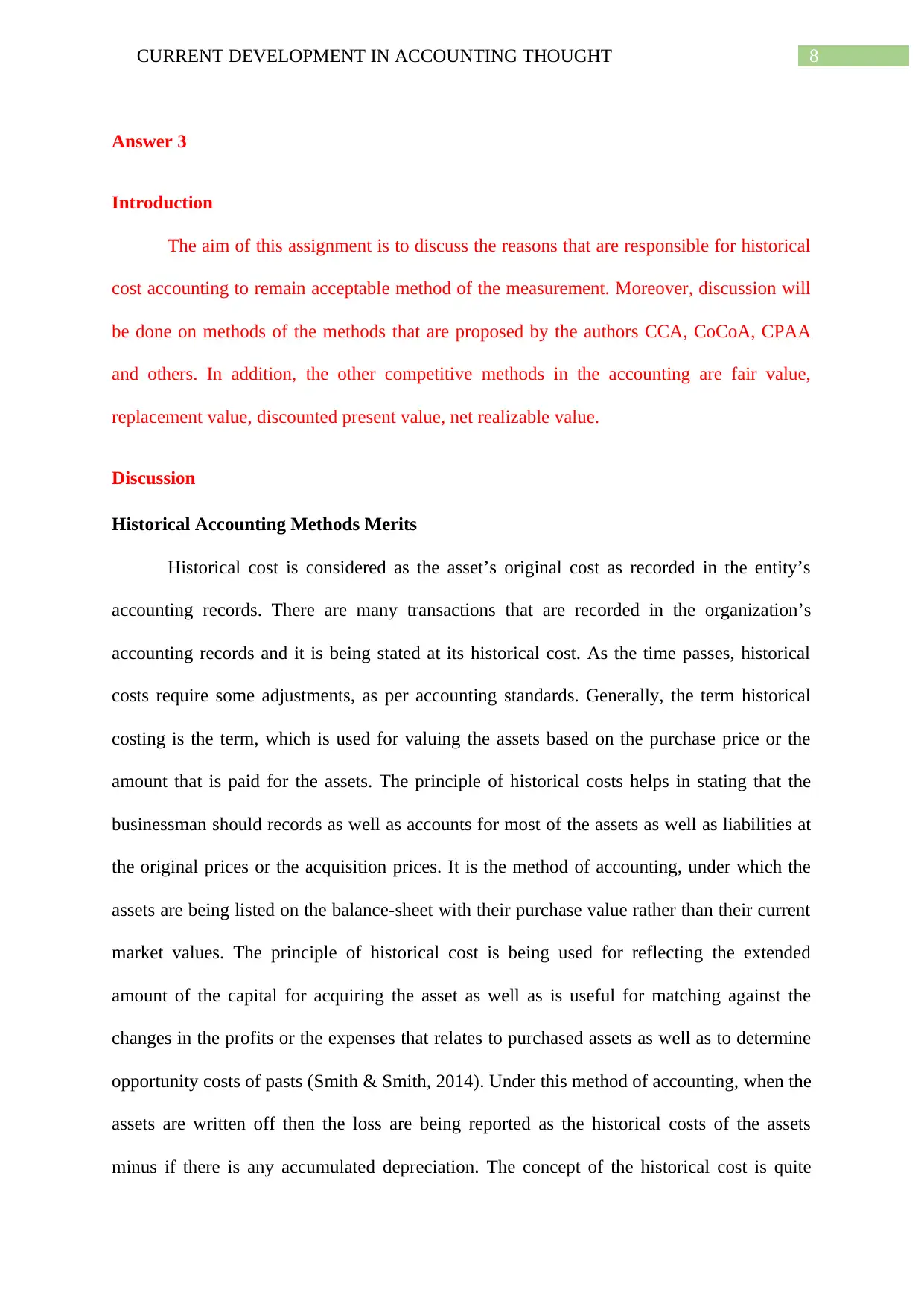
8CURRENT DEVELOPMENT IN ACCOUNTING THOUGHT
Answer 3
Introduction
The aim of this assignment is to discuss the reasons that are responsible for historical
cost accounting to remain acceptable method of the measurement. Moreover, discussion will
be done on methods of the methods that are proposed by the authors CCA, CoCoA, CPAA
and others. In addition, the other competitive methods in the accounting are fair value,
replacement value, discounted present value, net realizable value.
Discussion
Historical Accounting Methods Merits
Historical cost is considered as the asset’s original cost as recorded in the entity’s
accounting records. There are many transactions that are recorded in the organization’s
accounting records and it is being stated at its historical cost. As the time passes, historical
costs require some adjustments, as per accounting standards. Generally, the term historical
costing is the term, which is used for valuing the assets based on the purchase price or the
amount that is paid for the assets. The principle of historical costs helps in stating that the
businessman should records as well as accounts for most of the assets as well as liabilities at
the original prices or the acquisition prices. It is the method of accounting, under which the
assets are being listed on the balance-sheet with their purchase value rather than their current
market values. The principle of historical cost is being used for reflecting the extended
amount of the capital for acquiring the asset as well as is useful for matching against the
changes in the profits or the expenses that relates to purchased assets as well as to determine
opportunity costs of pasts (Smith & Smith, 2014). Under this method of accounting, when the
assets are written off then the loss are being reported as the historical costs of the assets
minus if there is any accumulated depreciation. The concept of the historical cost is quite
Answer 3
Introduction
The aim of this assignment is to discuss the reasons that are responsible for historical
cost accounting to remain acceptable method of the measurement. Moreover, discussion will
be done on methods of the methods that are proposed by the authors CCA, CoCoA, CPAA
and others. In addition, the other competitive methods in the accounting are fair value,
replacement value, discounted present value, net realizable value.
Discussion
Historical Accounting Methods Merits
Historical cost is considered as the asset’s original cost as recorded in the entity’s
accounting records. There are many transactions that are recorded in the organization’s
accounting records and it is being stated at its historical cost. As the time passes, historical
costs require some adjustments, as per accounting standards. Generally, the term historical
costing is the term, which is used for valuing the assets based on the purchase price or the
amount that is paid for the assets. The principle of historical costs helps in stating that the
businessman should records as well as accounts for most of the assets as well as liabilities at
the original prices or the acquisition prices. It is the method of accounting, under which the
assets are being listed on the balance-sheet with their purchase value rather than their current
market values. The principle of historical cost is being used for reflecting the extended
amount of the capital for acquiring the asset as well as is useful for matching against the
changes in the profits or the expenses that relates to purchased assets as well as to determine
opportunity costs of pasts (Smith & Smith, 2014). Under this method of accounting, when the
assets are written off then the loss are being reported as the historical costs of the assets
minus if there is any accumulated depreciation. The concept of the historical cost is quite
⊘ This is a preview!⊘
Do you want full access?
Subscribe today to unlock all pages.

Trusted by 1+ million students worldwide
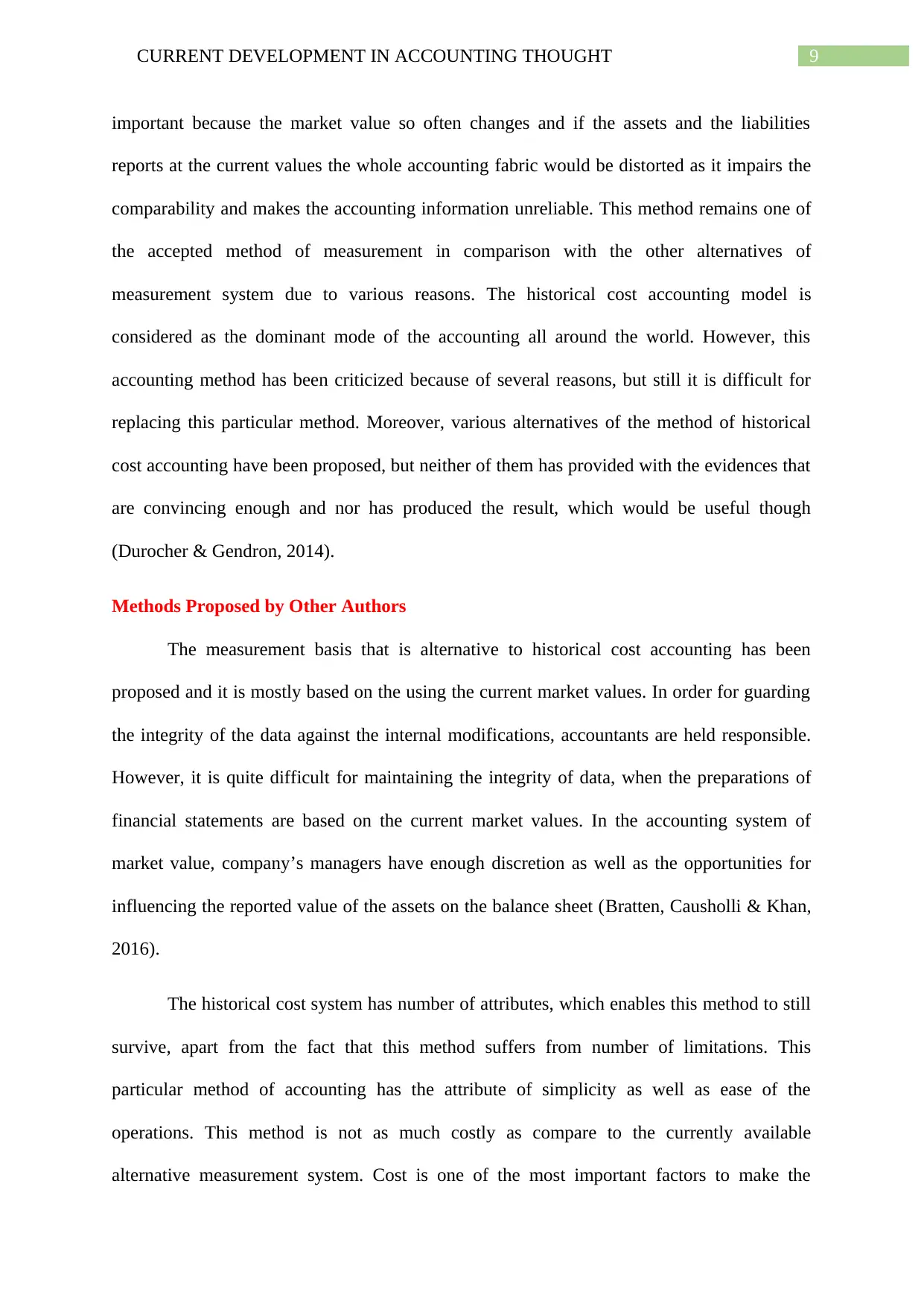
9CURRENT DEVELOPMENT IN ACCOUNTING THOUGHT
important because the market value so often changes and if the assets and the liabilities
reports at the current values the whole accounting fabric would be distorted as it impairs the
comparability and makes the accounting information unreliable. This method remains one of
the accepted method of measurement in comparison with the other alternatives of
measurement system due to various reasons. The historical cost accounting model is
considered as the dominant mode of the accounting all around the world. However, this
accounting method has been criticized because of several reasons, but still it is difficult for
replacing this particular method. Moreover, various alternatives of the method of historical
cost accounting have been proposed, but neither of them has provided with the evidences that
are convincing enough and nor has produced the result, which would be useful though
(Durocher & Gendron, 2014).
Methods Proposed by Other Authors
The measurement basis that is alternative to historical cost accounting has been
proposed and it is mostly based on the using the current market values. In order for guarding
the integrity of the data against the internal modifications, accountants are held responsible.
However, it is quite difficult for maintaining the integrity of data, when the preparations of
financial statements are based on the current market values. In the accounting system of
market value, company’s managers have enough discretion as well as the opportunities for
influencing the reported value of the assets on the balance sheet (Bratten, Causholli & Khan,
2016).
The historical cost system has number of attributes, which enables this method to still
survive, apart from the fact that this method suffers from number of limitations. This
particular method of accounting has the attribute of simplicity as well as ease of the
operations. This method is not as much costly as compare to the currently available
alternative measurement system. Cost is one of the most important factors to make the
important because the market value so often changes and if the assets and the liabilities
reports at the current values the whole accounting fabric would be distorted as it impairs the
comparability and makes the accounting information unreliable. This method remains one of
the accepted method of measurement in comparison with the other alternatives of
measurement system due to various reasons. The historical cost accounting model is
considered as the dominant mode of the accounting all around the world. However, this
accounting method has been criticized because of several reasons, but still it is difficult for
replacing this particular method. Moreover, various alternatives of the method of historical
cost accounting have been proposed, but neither of them has provided with the evidences that
are convincing enough and nor has produced the result, which would be useful though
(Durocher & Gendron, 2014).
Methods Proposed by Other Authors
The measurement basis that is alternative to historical cost accounting has been
proposed and it is mostly based on the using the current market values. In order for guarding
the integrity of the data against the internal modifications, accountants are held responsible.
However, it is quite difficult for maintaining the integrity of data, when the preparations of
financial statements are based on the current market values. In the accounting system of
market value, company’s managers have enough discretion as well as the opportunities for
influencing the reported value of the assets on the balance sheet (Bratten, Causholli & Khan,
2016).
The historical cost system has number of attributes, which enables this method to still
survive, apart from the fact that this method suffers from number of limitations. This
particular method of accounting has the attribute of simplicity as well as ease of the
operations. This method is not as much costly as compare to the currently available
alternative measurement system. Cost is one of the most important factors to make the
Paraphrase This Document
Need a fresh take? Get an instant paraphrase of this document with our AI Paraphraser
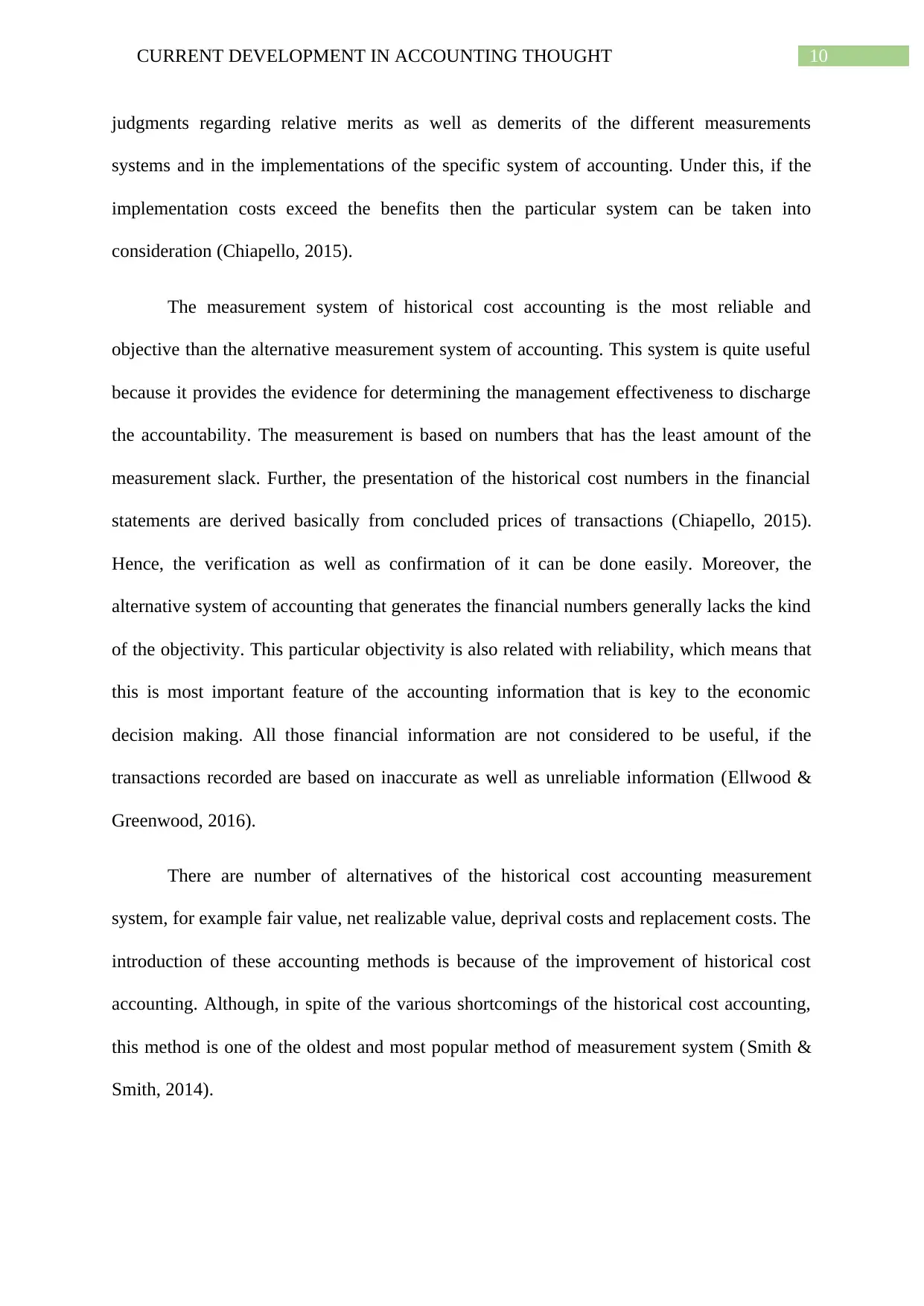
10CURRENT DEVELOPMENT IN ACCOUNTING THOUGHT
judgments regarding relative merits as well as demerits of the different measurements
systems and in the implementations of the specific system of accounting. Under this, if the
implementation costs exceed the benefits then the particular system can be taken into
consideration (Chiapello, 2015).
The measurement system of historical cost accounting is the most reliable and
objective than the alternative measurement system of accounting. This system is quite useful
because it provides the evidence for determining the management effectiveness to discharge
the accountability. The measurement is based on numbers that has the least amount of the
measurement slack. Further, the presentation of the historical cost numbers in the financial
statements are derived basically from concluded prices of transactions (Chiapello, 2015).
Hence, the verification as well as confirmation of it can be done easily. Moreover, the
alternative system of accounting that generates the financial numbers generally lacks the kind
of the objectivity. This particular objectivity is also related with reliability, which means that
this is most important feature of the accounting information that is key to the economic
decision making. All those financial information are not considered to be useful, if the
transactions recorded are based on inaccurate as well as unreliable information (Ellwood &
Greenwood, 2016).
There are number of alternatives of the historical cost accounting measurement
system, for example fair value, net realizable value, deprival costs and replacement costs. The
introduction of these accounting methods is because of the improvement of historical cost
accounting. Although, in spite of the various shortcomings of the historical cost accounting,
this method is one of the oldest and most popular method of measurement system (Smith &
Smith, 2014).
judgments regarding relative merits as well as demerits of the different measurements
systems and in the implementations of the specific system of accounting. Under this, if the
implementation costs exceed the benefits then the particular system can be taken into
consideration (Chiapello, 2015).
The measurement system of historical cost accounting is the most reliable and
objective than the alternative measurement system of accounting. This system is quite useful
because it provides the evidence for determining the management effectiveness to discharge
the accountability. The measurement is based on numbers that has the least amount of the
measurement slack. Further, the presentation of the historical cost numbers in the financial
statements are derived basically from concluded prices of transactions (Chiapello, 2015).
Hence, the verification as well as confirmation of it can be done easily. Moreover, the
alternative system of accounting that generates the financial numbers generally lacks the kind
of the objectivity. This particular objectivity is also related with reliability, which means that
this is most important feature of the accounting information that is key to the economic
decision making. All those financial information are not considered to be useful, if the
transactions recorded are based on inaccurate as well as unreliable information (Ellwood &
Greenwood, 2016).
There are number of alternatives of the historical cost accounting measurement
system, for example fair value, net realizable value, deprival costs and replacement costs. The
introduction of these accounting methods is because of the improvement of historical cost
accounting. Although, in spite of the various shortcomings of the historical cost accounting,
this method is one of the oldest and most popular method of measurement system (Smith &
Smith, 2014).
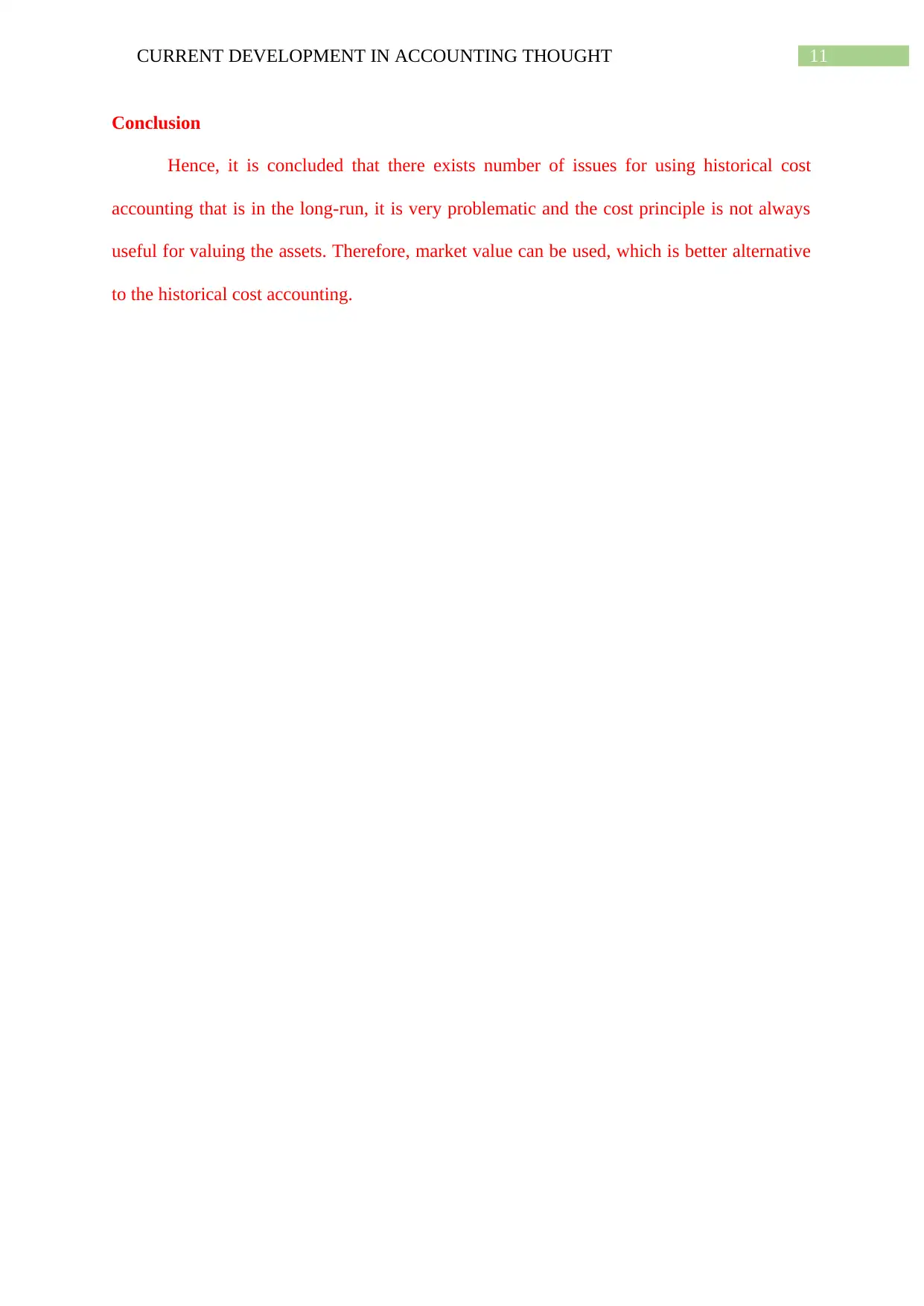
11CURRENT DEVELOPMENT IN ACCOUNTING THOUGHT
Conclusion
Hence, it is concluded that there exists number of issues for using historical cost
accounting that is in the long-run, it is very problematic and the cost principle is not always
useful for valuing the assets. Therefore, market value can be used, which is better alternative
to the historical cost accounting.
Conclusion
Hence, it is concluded that there exists number of issues for using historical cost
accounting that is in the long-run, it is very problematic and the cost principle is not always
useful for valuing the assets. Therefore, market value can be used, which is better alternative
to the historical cost accounting.
⊘ This is a preview!⊘
Do you want full access?
Subscribe today to unlock all pages.

Trusted by 1+ million students worldwide
1 out of 15
Related Documents
Your All-in-One AI-Powered Toolkit for Academic Success.
+13062052269
info@desklib.com
Available 24*7 on WhatsApp / Email
![[object Object]](/_next/static/media/star-bottom.7253800d.svg)
Unlock your academic potential
Copyright © 2020–2025 A2Z Services. All Rights Reserved. Developed and managed by ZUCOL.





